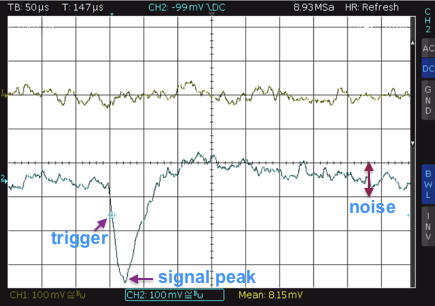Workshop conductor: Oliver
Participants: Saad, Alex, Pollock, JP, Rachel, Doria, Chris, Hamish, Andrew, Ben, Valerian
Summary
This workshop was focused on DIY soldering a silicon diode-based particle detector (as in radioactivity; not related to air quality) consisting of a few through-hole parts and analog operational amplifier circuit. 9 detectors have been built, 7 using the well working BPW 34 diode and 2 using a larger 6x6 mm diode from the electronic markets in Shenzhen. The protective glass cover of the latter was removed forcefully which is why those should be sensitive to alpha particles (to be examined further).
We spent up to 2 hours with soldering and getting to know the parts. The basics of this solid state detector design have been explained in a short walk through. In summary: Ionising radiation - like electrons from beta decays - interacting within the sensitive volume of the silicon PIN diode produces a tiny current pulse which is amplified into a voltage pulse to be measured by an oscilloscope or using a computer sound input/headset port. The Processing.org sketch for using a simple computer audio connector instead of an oscilloscope can be found here: https://github.com/ozel/WaveWatch
Notes
The output signal of the detector on the scope should look similar to this:

Usefull oscilloscope settings are:
- AC or DC coupled input channel, 1 MOhm impedance (standard)
- y-scale: 100 mV per DIV
- x-scale: 50 us per DIV
- trigger: negative edge, trigger level typically at about - 80 mV below zero (well outside of noise range)
Troubleshooting:
- The circuit must be completely inside a metallic case and the ground connection (e.g. the “-” pin at the signal output connector) must be somewhere well connected to the metal of the case. (otherwise there’s no proper Faraday cage to shield the sensitive circuit from external EM fields).
The stacked & cut beer cans we tried in the workshop are probably a bad idea since their inner side is covered with a plastic foil! Well working cases are tin boxes for candies, e.g. Altoids tin cans - there must be absolutely no light coming inside. the silicon diodes have to be in absolute darkness. One way this will show up on the scope is with an unusual low noise range (less than 20 mV). Solution: Add more black tape to any little opening or hole that you can find.
- If there are still no pulses, check the battery. While connected, it should have at least 7.5 Volts left. Overall run time is typically below 10 hours, depending on the 9V battery model.
- If still no luck with hunting particles please post a message below or write me directly. There should be at least one pulse within 5 minutes, even without any extra source (cosmics and U/Th in the soil reach us everywhere
 ). Some potassium salt (KCL), a small piece of Uranium glass or Radon collected with a balloon will result in several counts per minute or even second depending on the amount.
). Some potassium salt (KCL), a small piece of Uranium glass or Radon collected with a balloon will result in several counts per minute or even second depending on the amount.
Update: (October 2019  )
)
Detailed paper about the DIY diode detector with background on the silicon sensor:
All hardware details, build instructions and analysis software etc.:
